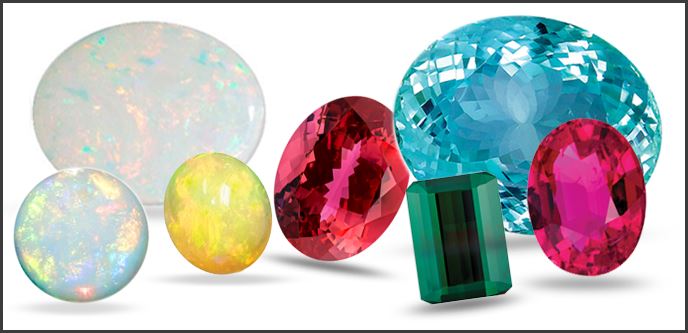October Birthstone: Tourmaline and Opal
- by Shop RMC
-

October also has two birthstones; Tourmaline and Opal. Tourmaline is a favorite gemstone for many because it’s available in a rainbow of beautiful colors. Opal gemstones are truly unique because each individual gem is adorned with a one-of-a-kind color combination.
Learn more about these two October birthstones and discover the perfect gift for those born in the tenth month.
The name of this, the traditional October birthstone, is believed to have originated in India (the source of the first opals brought to the Western world), where in Sanskrit it was called upala, a “precious stone." .” In ancient Rome, this became opalus. Most opals are valued for their shifting colors in rainbow hues – a phenomenon known as “play-of-color.”
The October birthstone’s dramatic play-of-color has inspired writers to compare it to fireworks, galaxies and volcanoes. Bedouins once believed opal held lightning and fell from the sky during thunderstorms. Ancient Greeks thought opals bestowed the gift of prophesy and protection from disease. Europeans long maintained opal to be a symbol of purity, hope and truth. Hundreds of years ago, opal was believed to embody the virtues and powers of all colored stones.

Opal is also the stone given to celebrate the 14th wedding anniversary.
WHERE IS OPAL FOUND?
The opal birthstone can be found in many places. The fields of Australia are the most productive in the world for the October birthstone. Ethiopia, Mexico and Brazil are also important sources. Additional deposits have been found in Central Europe, Honduras, Indonesia, Madagascar, Peru, Turkey and the United States.
Lightning Ridge, a small town in New South Wales, Australia, is famed for producing prized black opal. A dry and rocky region softened only by small trees and scrub brush, Lightning Ridge gets little rain and bakes in the scorching summer temperatures. The climate is so unforgiving that miners often live underground to find respite from the punishing heat.
TOURMALINE BIRTHSTONE MEANING & HISTORY
Tourmaline is the newer October birthstone. The name comes from the Sinhalese word toramalli, which means “stone with mixed colors,” because it often has multiple colors in one crystal. Very few gems match tourmaline’s dazzling array of colors. Perhaps this is why ancient mystics believed this October birthstone could inspire artistic expression – it has a color palette for every mood. Among the most popular are the pink and red rubellites, the emerald green “chrome” tourmalines, and the neon green and blue-to-violet “paraíba” tourmalines.
Because of its vast range of colors, tourmaline was often mistaken for other gemstones One of the “rubies” in the Russian crown jewels, the “Caesar’s Ruby” pendant, is actually red (rubellite) tourmaline. A Spanish conquistador found green tourmaline crystals in Brazil in the 1500s and confused the stones with emerald. These and other cases of mistaken identity continued for centuries until scientists recognized tourmaline as a distinct mineral species in the 1800s.

Different colors of tourmaline are thought to have their own healing properties. Black tourmaline is believed to protect the wearer and give a sense of self-confidence. Pink tourmaline embodies love and is associated with compassion and gentleness. Green tourmaline promotes courage, strength and stamina. Tourmaline is given to celebrate the eighth wedding anniversary.
WHERE IS TOURMALINE FOUND?
This October birthstone is most commonly found in Brazil, but it is also mined in Afghanistan, Pakistan, Kenya, Madagascar and Mozambique (among other countries in Africa). California and Maine are historically important producers of fine tourmaline in the United States.
Most of the tourmaline mined in Brazil over the centuries comes from pegmatites in the state of Minas Gerais. These subterranean intrusions of magma are the source of a virtual kaleidoscope of gem minerals. In the late 1980s, however, electric green, blue and violet tourmalines entered the gem market from pegmatites in Brazil’s Paraíba State. Scientists found that the intense colors were caused by trace amounts of copper, which had previously not been recorded as a coloring agent in any other tourmaline. In the early 2000s, Paraíba-type copper-bearing tourmalines were also discovered in Mozambique and Nigeria. Overall, prices for the best Paraíba and Paraíba-type tourmalines easily surpass other tourmalines due to their vivid hues, higher color saturation and greater rarity.
In the United States, both Southern California and Maine host several pegmatite districts. For more than a century, they have sporadically yielded large quantities of tourmaline.
Maine’s first major tourmaline deposit was discovered in 1820 at Mount Mica in Paris, by two young boys exploring the local area. Even today, a quarry at Mount Mica intermittently produces various colors of gem tourmaline. The Dunton mine, near Plumbago Mountain, is the most prolific producer of tourmaline in Maine.
In 1898, California’s first commercial tourmaline mine opened at the Himalaya pegmatite in the Mesa Grande district – famed for the production of fine rubellite. To feed Empress Dowager Cixi’s obsession with the vibrant color, San Diego mines sent 120 tons of gem rubellite to Imperial China between 1902 and 1910. With the death of Cixi in 1908 and the subsequent overthrow of the Qing dynasty, the heyday of tourmaline mining in California ended. Today, only a few mines in San Diego County occasionally produce gem-quality tourmaline.
TOURMALINE BIRTHSTONE CARE & CLEANING
The tourmaline birthstone is rated 7 to 7.5 on the Mohs scale of hardness and is generally suitable for everyday wear. These colorful gems are usually stable enough to withstand light and most chemicals, but heat can be damaging. This October birthstone is best cleaned with warm, soapy water and a soft brush The use of ultrasonic and steam cleaners is not recommended.





